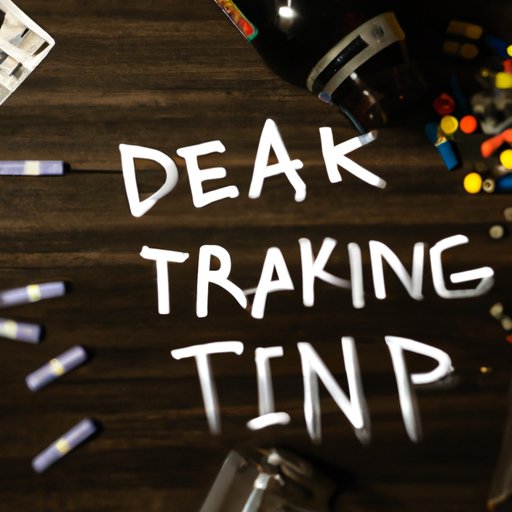Introduction: What is a Bad Trip?
A bad trip is an intense and often negative psychological experience that can happen when someone uses drugs or alcohol. It is characterized by fear, anxiety, confusion, and paranoia. While it is most commonly associated with psychedelic substances such as LSD, shrooms, and DMT, it can also occur with other mind-altering substances, including alcohol and marijuana.

Causes of a Bad Trip: Identifying Potential Triggers
Though the exact cause of a bad trip is unknown, there are several factors that may increase the risk. Understanding these triggers can help someone identify ways to prevent or manage a difficult experience.
Drug or Alcohol Use
The primary factor that increases the risk of a bad trip is the type and amount of drug taken. Some substances are more likely to produce negative side effects than others, and certain combinations can be especially risky. For example, taking psychedelics with alcohol or other drugs can increase the intensity and duration of the experience.
Psychological Factors
Mental health can also play a role in a bad trip. People who have a history of anxiety, depression, or other mental health conditions may be more likely to experience a negative reaction. Additionally, those who are feeling emotionally vulnerable or distressed prior to taking the drug are at greater risk.
Environmental Factors
The environment in which the drug is taken is also important. A bad trip is more likely to occur if the person is in an unfamiliar or uncomfortable setting. Loud noises, bright lights, and large crowds can also contribute to a negative experience.
Signs and Symptoms of a Bad Trip
The signs and symptoms of a bad trip vary depending on the individual and the substance used. Common reactions include intense fear, paranoia, confusion, and anxiety. Other physical and emotional responses may include nausea, vomiting, sweating, and rapid heart rate.
Physiological Reactions
Physical reactions to a bad trip can range from mild to severe. These may include nausea, vomiting, sweating, increased heart rate, and dizziness. In extreme cases, a person may experience seizures or hallucinations.
Emotional Reactions
Negative emotions are common during a bad trip. People may feel overwhelmed, scared, anxious, paranoid, or helpless. They may also experience feelings of guilt, shame, or regret.
Cognitive Reactions
Cognitive changes may occur during a bad trip, including difficulty concentrating, disorientation, and altered perception of time and space. The person may also have distorted thoughts and beliefs, and they may struggle to make sense of their surroundings.

How to Avoid a Bad Trip
Though a bad trip cannot always be prevented, there are steps you can take to reduce the risk. Taking the following precautions can help ensure a more positive experience.
Understand the Risk Factors
Understanding the potential triggers for a bad trip is essential. Knowing which drugs are more likely to produce a negative reaction, as well as any psychological or environmental factors that could increase the risk, can help you prepare for the experience.
Choose Your Setting Wisely
Creating a safe and comfortable environment is key to avoiding a bad trip. Choose a setting that is familiar and free of distractions. Make sure the people around you are supportive and understanding, and keep the noise and light levels low.
Know Your Limits
It’s important to know your limits when using drugs or alcohol. Start with a small dose and wait until the effects are felt before taking more. Don’t mix different types of substances, and avoid taking higher doses than recommended.
What to Do if You’re Having a Bad Trip
If you find yourself having a bad trip, there are steps you can take to manage the situation. Staying calm and seeking support can help you get through the experience in one piece.
Stay Calm
Remaining calm is essential during a bad trip. If you start to feel overwhelmed, take deep breaths and focus on grounding techniques, such as repeating a mantra or focusing on a particular object.
Seek Support
Having someone nearby who can provide reassurance and comfort can be helpful. Choose someone who is understanding and nonjudgmental. Talking to them can help you gain perspective and manage your emotions.
Reduce Stimulation
Limiting your exposure to sensory stimulation can also be beneficial. Move to a darker, quieter area, put on some soothing music, and avoid bright lights and loud noises.

Coping Strategies for Dealing With a Bad Trip
There are several effective strategies for managing a bad trip. These can help you process the experience, move past it, and come out stronger on the other side.
Grounding Techniques
Practicing grounding techniques can help you stay present and focused. This can involve repeating a mantra, counting objects in the room, or focusing on a particular object. According to research, “these techniques can help people become aware of their physical environment and can increase their sense of safety.” 1
Talk to Someone
Talking to a trusted friend or family member can be helpful during a bad trip. Expressing your feelings and gaining perspective can help you process the experience and move past it.
Focus on the Positive
Though it may be hard, try to focus on the positive aspects of the experience. Reminding yourself that the feelings are temporary can help you stay grounded and maintain perspective.
The Long-Term Effects of a Bad Trip
Though a bad trip usually passes after a few hours, it can have long-lasting effects on mental and physical health. It is important to understand these risks so you can take steps to protect your wellbeing.
Mental Health Risks
A bad trip can trigger or worsen mental health conditions such as depression, anxiety, and post-traumatic stress disorder (PTSD). It can also cause flashbacks, intrusive thoughts, nightmares, and difficulty concentrating.
Physical Health Risks
Physical health risks associated with a bad trip include dehydration, exhaustion, and impaired judgment. In extreme cases, a person may suffer serious physical injuries or even death.
Social Effects
The social effects of a bad trip can linger long after the experience. It can lead to strained relationships, social isolation, and difficulty trusting others.
Tips for Supporting Someone Through a Bad Trip
If you find yourself in a situation where someone is having a bad trip, there are steps you can take to offer support and comfort.
Listen Carefully
Listening without judgment is key. Let the person express their feelings without interruption or criticism. Validate their experience and let them know they are not alone.
Be Patient and Nonjudgmental
Be patient and understanding. Try to remain calm and don’t rush the person. Avoid making judgments or giving advice, as this can make them feel worse.
Offer Comfort and Encouragement
Provide comfort and reassurance. Offer words of encouragement and remind the person that the experience is temporary. Offer to stay with them and help them stay grounded and focused.
Conclusion
A bad trip is an intense and often negative psychological experience that can occur when someone uses drugs or alcohol. Though the exact cause is unknown, there are several potential triggers, including drug and alcohol use, psychological factors, and environmental factors. Common signs and symptoms include physical reactions, emotional reactions, and cognitive reactions. To reduce the risk of a bad trip, it is important to understand the risk factors, choose your setting wisely, and know your limits. If you find yourself in a bad trip, staying calm and seeking support can help you manage the situation. Finally, a bad trip can have long-term effects on mental and physical health, and knowing how to support someone through the experience is essential.
Summary of Key Points
In summary, a bad trip is an intense and often negative psychological experience that can occur when someone uses drugs or alcohol. The causes of a bad trip are not fully understood, though drug and alcohol use, psychological factors, and environmental factors can increase the risk. Signs and symptoms include physical reactions, emotional reactions, and cognitive reactions. To reduce the risk of a bad trip, it is important to understand the risk factors, choose your setting wisely, and know your limits. Coping strategies for dealing with a bad trip include grounding techniques, talking to someone, and focusing on the positive. Finally, a bad trip can have long-term effects on mental and physical health, and knowing how to support someone through the experience is essential.
Final Thoughts
Experiencing a bad trip can be frightening, but it is important to remember that the feelings are temporary. Learning to recognize the signs and symptoms of a bad trip, as well as understanding the potential triggers and how to cope with the experience, can help you stay safe and protect your wellbeing.
(Note: Is this article not meeting your expectations? Do you have knowledge or insights to share? Unlock new opportunities and expand your reach by joining our authors team. Click Registration to join us and share your expertise with our readers.)
